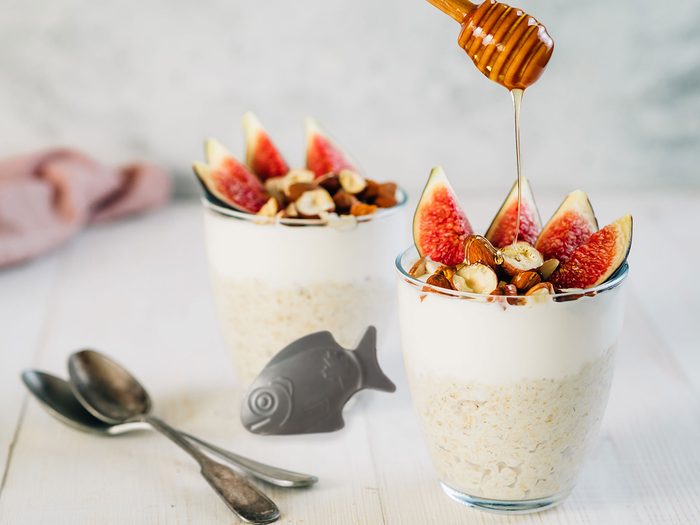Can a Little Metal Fish Help Me With My Iron Deficiency?

The Lucky Iron Fish releases easily absorbable iron particles when placed in a pot of water with a few drops of acidity—but is it enough to significantly boost iron levels? We tried it to find out.
Between 20 and 25 percent of the world is iron deficient, according to Statistics Canada, and about nine percent of Canadian women between the ages of 20 and 49 are lacking in this important nutrient. Aside from fatigue and weakness, iron deficiency can cause irritability, headaches and dizziness, and cold feet and hands, among other symptoms. Iron deficiency is particularly common for those with heavy periods, or those who are vegetarian or vegan.
I eat tons of leafy greens and meat, but I’ve been iron deficient for decades nonetheless, according to my bloodwork. (I blame heavy periods, or some sort of absorption issue.)
In my perpetual quest to add even more iron to my rotation, I recently tried the Lucky Iron Fish, a fits-in-your-palm piece of metal you place in a pot of water along with a few drops of acidity, such as lemon juice or vinegar, and then boil for 10 minutes. The boiling water releases easily absorbable iron particles from the fish and creates iron-infused water you can use later on (for example, in teas or smoothies, or to cook oatmeal or rice). You can also simply add the Iron Fish to the pot when you’re making things like soup, sauce, curry or pasta. Often, the acidity in the veggies you add, or in the stock or tomato sauce, is enough to release the iron particles.
According to Michelle Cohen, a family physician in Brighton, Ont., who focuses on debunking alternative medicine and wellness trends, using the Lucky Iron Fish isn’t an issue—but it’s also probably not going to make much of a dent if you’re truly iron deficient, like I am. (Without supplementation—a.k.a. iron pills—my ferritin levels hover around 6 or 8, whereas normal levels should be in the 60 to 140 mcg/dL range. My iron levels are too low to donate blood, even.)
The iron fish “can be a helpful tool, but it’s probably not enough supplementation on its own for a large deficiency,” says Cohen. “Cooking in a cast iron pan can help a bit, too. Both are good, passive options to boost dietary iron that are easy on the gut, but they might be better for maintaining already sufficient iron levels or being used in combination with oral supplementation.”
When I discussed my chronic iron issues with Amauri Caversan, a naturopathic doctor in Toronto, he told me the Lucky Iron Fish is not dissimilar from a home remedy in Brazil, where this deficiency is common, especially in impoverished communities. He says families there are sometimes told to put an old rusty nail in their pot of beans as a way to incorporate more iron over time.
According to the manufacturer, the Lucky Iron Fish releases six to eight mg of iron per use, which is about the same as eating an eight-ounce steak or eight cups of raw spinach. But each capsule of FeraMAX, the iron pill brand my doctor recommends, contains a whopping 150 mg of elemental iron: a much heavier dose.
Some people have a hard time taking their iron supplements consistently because the pills can cause constipation, diarrhea, gastric pain, nausea or black or dark-green poop (while that last phenomenon is weird, it’s not actually harmful). Iron supplements also aren’t covered by my insurance, and the ones I use cost about $30 a box, which can also be a deterrent. (Each box lasts me about a month.) The Iron Fish is marketed as a gentler option, with fewer side effects, and it only costs $50. It’s reusable for five years or more.
I did find that the fish rusts easily if you don’t care for it as directed—this was my only complaint. After washing it with soap and water, you must hand-dry it completely. (It will definitely rust if you let it air-dry.) And, after each use, you’ll need to treat the fish with the bottle of “protection oil” it comes with, too. But, apart from that small maintenance effort, it’s small, cute and you can keep it on your counter or stovetop to make it easy to remember to plop it into a dish while cooking, no harm done.
Cohen encouraged me to stick with my FeraMAX iron pills—which give me very few side effects compared to other brands I’ve tried—and she says that anyone who’s iron deficient should experiment with various formulations. “There are lots of different iron supplements out there, so people shouldn’t feel discouraged if one type of iron bothers their gut,” she says.
When Caversan’s clients report that they aren’t tolerating their iron pills well, he suggests trying heme-iron (as opposed to non-heme iron) pills. This may not work for vegans and vegetarians, however: Heme iron is derived from meat, poultry and seafood, whereas non-heme iron is found in plant foods like leafy greens, legumes, nuts, seeds and whole grains.
Cohen advises her patients to take iron on an empty stomach, but with vitamin C—a glass of orange juice is a popular option—to increase absorption. (Taking iron on a fuller stomach will likely mean fewer gastric issues, but it can also lower your absorption rates.) You could ask your doctor about taking an iron pill every other day, she notes, or just a few times a week.
Because I’m being more diligent about my iron pills and trying out the Iron Fish concurrently, it’s hard to evaluate which one is more effective. But I do know that cooking with the fish can’t hurt.




